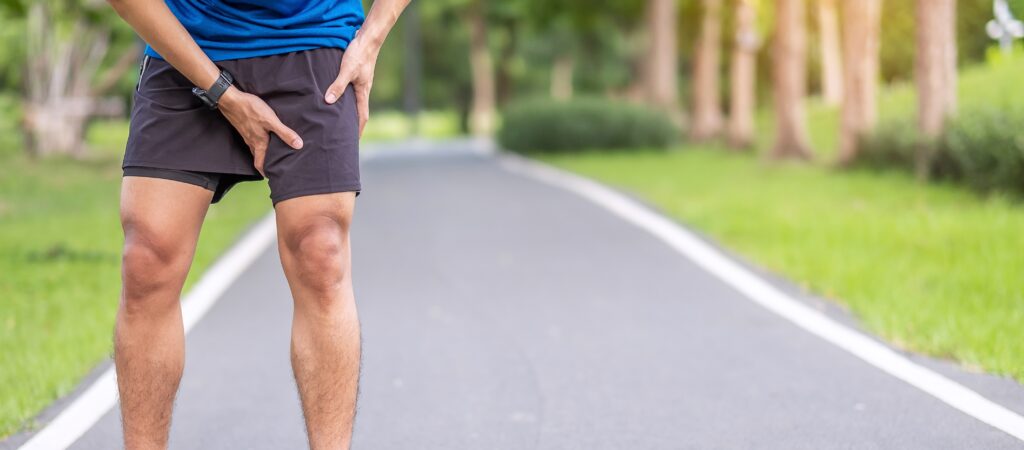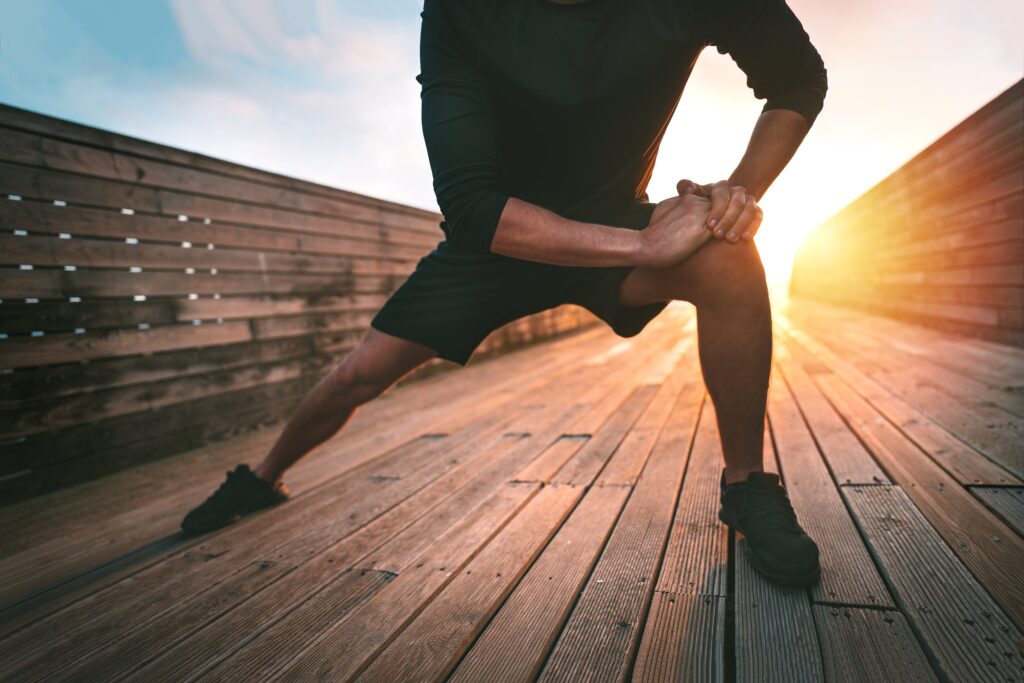Groin muscle strains and pulls are common injuries that can significantly impact an individual’s mobility and quality of life. These types of muscle injuries occur in the inner thigh area, where the abdominal muscles meet the leg, and can range from mild to severe.

What is a Groin Strain?
A groin strain, also known as a groin pull, is an injury to the adductor muscles of the inner thigh. These muscles, which bring the legs together, can get overstretched or torn during sudden, intense activities. Groin strains are classified into three grades based on the extent of the muscle damage:
Grade 1 Groin Strain
A Grade 1 strain is a minor stretch or tear, usually affecting less than 5% of the muscle. People with this type of strain might feel discomfort and tenderness in their groin, but they can often still walk and do light activities without much pain.
Grade 2 Groin Strain
A Grade 2 strain is more serious, with a larger part of the muscle being torn. This type of injury can cause noticeable pain, weakness, and difficulty with activities that involve leg movement, like walking or running.
Grade 3 Groin Strain
A Grade 3 groin strain is the most severe, involving a complete or near-complete muscle tear. This type of injury often results in immediate and severe pain, significant swelling, and the inability to bear weight on the affected leg.
Causes and Risk Factors of Groin Strains
Groin strains are commonly associated with athletic activities that involve sudden changes in direction, rapid acceleration, or forceful leg movements, such as kicking or jumping. Soccer, hockey, football, and dance are prone to groin injuries. But groin strains can also occur during everyday activities, such as lifting heavy objects or slipping while walking.
Several risk factors can increase the likelihood of experiencing a groin strain, including.
- Lack of flexibility or strength in the hip and groin muscles
- Previous history of groin injuries
- Sudden increases in physical activity or intensity
- Poor form during athletic activities
- Not warming up or cooling down properly
Symptoms of Groin Strains
The main signs of a groin strain are pain, swelling, and tenderness in the inner thigh or groin area. People with a groin strain might also experience:
- Trouble walking or putting weight on the affected leg
- Leg weakness or instability
- Muscle spasms or tightness in the groin
- Bruising or discoloration in the injured area
- Popping or snapping sensation at the time of injury (in severe cases)
Diagnosing Groin Strains
When you see a doctor for a possible groin strain, they usually start with a thorough check-up. This might include looking at how well you can move your hip and leg, feeling the sore area to see where and how bad the injury is, and doing tests to check your muscle strength and how well they work.
Sometimes, the doctor might order pictures like X-rays or MRI scans. These help rule out other reasons for groin pain, like a stress fracture or sports hernia. They also help doctors see what kind of groin strain you have and its severity.
Treatment Options
The first step in treating a groin strain usually involves RICE: Rest, Ice, Compression, and Elevation. This helps reduce pain, swelling, and further injury. Depending on how bad the strain is, other treatments might include:
Medications
Over-the-counter pain relievers like ibuprofen or naproxen can help with pain and swelling.
Physical Therapy
A physical therapist can create a special recovery plan with exercises to help you get back your flexibility, strength, and range of motion in the injured area. They might also use a massage, ultrasound, or electrical stimulation to help you heal.

Gradual Return to Activity
As your groin strain heals, your doctor or physical therapist will guide you through slowly returning to your usual activities, including sports or exercise. This is important to avoid getting hurt again and to ensure you fully recover.
Surgery (in severe cases)
In rare cases, especially with a Grade 3 groin strain or a complete muscle tear, surgery to fix the damaged tissues might be necessary. After surgery, a full recovery program is crucial to getting back to normal and preventing future problems.
Lifestyle Adjustments for Preventing Groin Strains
While you can’t always prevent groin strains, there are ways to lower your risk:
Maintain Flexibility and Strength
Regularly stretching and strengthening the muscles in your groin, hip, and core can make them more flexible and stable, which helps prevent strains.
Gradually Increase Activity Levels
Gradually increasing the intensity and length of your exercise instead of making sudden big changes can help your body adjust and prevent overuse injuries.
Proper Warm-up and Cool-down
A warm-up and cool-down routine before and after exercise helps prepare muscles and lower injury risks.

Proper Technique and Form
Correct techniques during sports activities, like kicking or changing direction, can reduce strain on the groin muscles.
Contact Dr. Howard for Treatment
Groin muscle injuries are common but often avoidable issues that significantly affect mobility and daily life. Getting prompt medical help, following a thorough recovery plan, and using preventive measures all contribute to positive outcomes and a return to favorite activities. If you’re experiencing a groin muscle injury, don’t wait. Contact Dr. Peter Howard, M.D., today for expert advice and personalized care. Together, we’ll create a plan to get you back on your feet and back to doing the activities you love.
